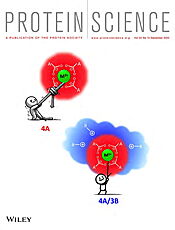Journal:Protein Science:4
From Proteopedia
(Difference between revisions)

| Line 1: | Line 1: | ||
<StructureSection load='' size='340' side='right' scene='10/1063617/009_figu_5b_png/3' caption='Acetylcholinesterase highlighting the 4A/3B motif'> | <StructureSection load='' size='340' side='right' scene='10/1063617/009_figu_5b_png/3' caption='Acetylcholinesterase highlighting the 4A/3B motif'> | ||
===Why is binding of a divalent metal cation to a structural motif containing four carboxylate residues not accompanied by a conformational change?=== | ===Why is binding of a divalent metal cation to a structural motif containing four carboxylate residues not accompanied by a conformational change?=== | ||
| - | + | <big>Lushchekina, Weiner, Ashani, Emrizal, Firdaus-Raih, Silman & Sussman</big><ref>PMID: 39548604</ref> | |
<hr/> | <hr/> | ||
<b>Molecular Tour</b><br>''Torpedo californica'' acetylcholinesterase (''Tc''AChE) contains a unique 4D motif composed of four aspartate residues that can bind divalent metal cations (like Ca²⁺, Mg²⁺, Mn²⁺), significantly increasing the enzyme’s thermal stability. Despite the electrostatic repulsion expected between these [[Image:2024_Lushchekina_Prot_Sci_x.jpg| thumb |left|175px|Comparison of a divalent cation being <i>pulled</i> out of a 4A vs a 4A/3B motif [https://doi.org/10.1002/pro.5206 Go to paper]]]aspartates, structural analysis shows that the enzyme's conformation remains stable | <b>Molecular Tour</b><br>''Torpedo californica'' acetylcholinesterase (''Tc''AChE) contains a unique 4D motif composed of four aspartate residues that can bind divalent metal cations (like Ca²⁺, Mg²⁺, Mn²⁺), significantly increasing the enzyme’s thermal stability. Despite the electrostatic repulsion expected between these [[Image:2024_Lushchekina_Prot_Sci_x.jpg| thumb |left|175px|Comparison of a divalent cation being <i>pulled</i> out of a 4A vs a 4A/3B motif [https://doi.org/10.1002/pro.5206 Go to paper]]]aspartates, structural analysis shows that the enzyme's conformation remains stable | ||
Revision as of 18:31, 18 November 2024
| |||||||||||
This page complements a publication in scientific journals and is one of the Proteopedia's Interactive 3D Complement pages. For aditional details please see I3DC.

